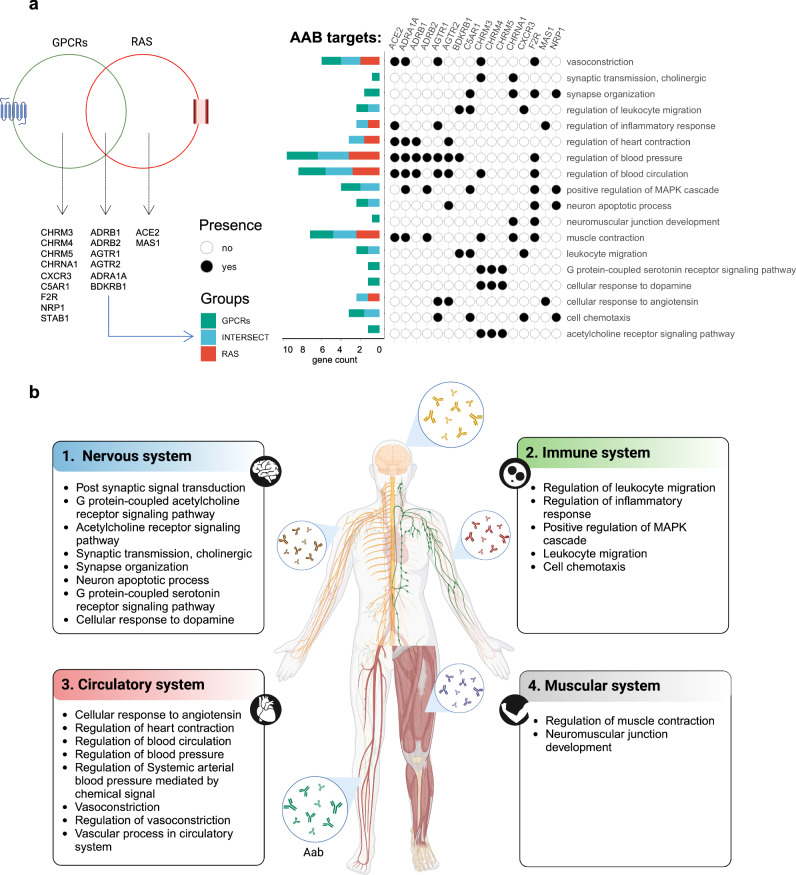Dysregulated autoantibodies targeting AGTR1 are associated with the accumulation of COVID-19 symptoms.
Coronavirus disease 2019 (COVID-19) presents a wide spectrum of symptoms, the causes of which remain poorly understood. This study explored the associations between autoantibodies (AABs), particularly those targeting G protein-coupled receptors (GPCRs) and renin‒angiotensin system (RAS) molecules, and the clinical manifestations of COVID-19. Using a cross-sectional analysis of 244 individuals, we applied multivariate analysis of variance, principal component analysis, and multinomial regression to examine the relationships between AAB levels and key symptoms. Significant correlations were identified between specific AABs and symptoms such as fever, muscle aches, anosmia, and dysgeusia. Notably, anti-AGTR1 antibodies, which contribute to endothelial glycocalyx (eGC) degradation, a process reversed by losartan, have emerged as strong predictors of core symptoms. AAB levels increased with symptom accumulation, peaking in patients exhibiting all four key symptoms. These findings highlight the role of AABs, particularly anti-AGTR1 antibodies, in determining symptom severity and suggest their involvement in the pathophysiology of COVID-19, including vascular complications.
Authors
Fonseca DLM, Jäpel M, Gyamfi MA, Filgueiras IS, Baiochi GC, et al.
External link
Publication Year
Publication Journal
Associeted Project
Systems Immunology of Human Diseases
Lista de serviços
-
StructRNAfinder: an automated pipeline and web server for RNA families prediction.StructRNAfinder: an automated pipeline and web server for RNA families prediction.
-
CEMiTool: a Bioconductor package for performing comprehensive modular co-expression analyses.CEMiTool: a Bioconductor package for performing comprehensive modular co-expression analyses.
-
webCEMiTool: Co-expression Modular Analysis Made Easy.webCEMiTool: Co-expression Modular Analysis Made Easy.
-
Assessing the Impact of Sample Heterogeneity on Transcriptome Analysis of Human Diseases Using MDP Webtool.Assessing the Impact of Sample Heterogeneity on Transcriptome Analysis of Human Diseases Using MDP Webtool.
-
Predicting RNA Families in Nucleotide Sequences Using StructRNAfinder.Predicting RNA Families in Nucleotide Sequences Using StructRNAfinder.
-
OUTBREAK: a user-friendly georeferencing online tool for disease surveillance.OUTBREAK: a user-friendly georeferencing online tool for disease surveillance.
-
Noninvasive prenatal paternity determination using microhaplotypes: a pilot study.Noninvasive prenatal paternity determination using microhaplotypes: a pilot study.
-
Editorial: User-Friendly Tools Applied to Genetics or Systems Biology.Editorial: User-Friendly Tools Applied to Genetics or Systems Biology.
-
Automatic detection of the parasite Trypanosoma cruzi in blood smears using a machine learning approach applied to mobile phone imagesAutomatic detection of the parasite Trypanosoma cruzi in blood smears using a machine learning approach applied to mobile phone images
-
Tucuxi-BLAST: Enabling fast and accurate record linkage of large-scale health-related administrative databases through a DNA-encoded approachTucuxi-BLAST: Enabling fast and accurate record linkage of large-scale health-related administrative databases through a DNA-encoded approach
-
Ten quick tips for harnessing the power of ChatGPT in computational biologyTen quick tips for harnessing the power of ChatGPT in computational biology

